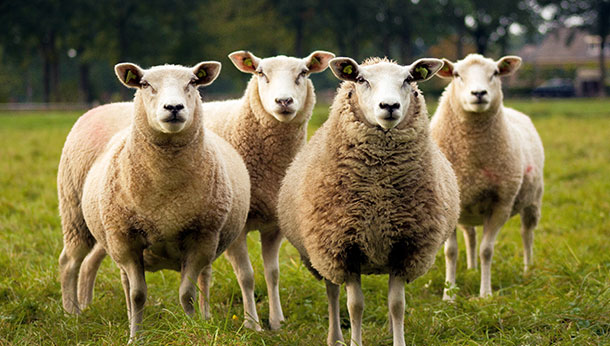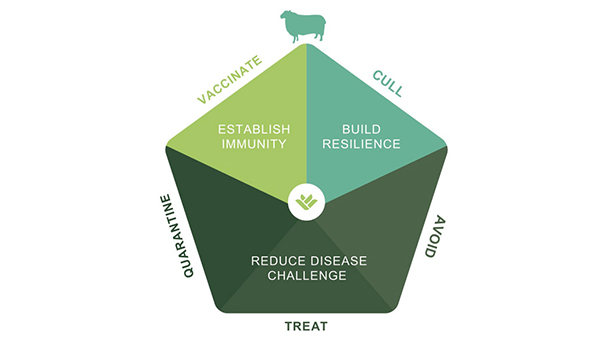
Lameness is one of the most widespread problems facing the UK sheep flock. An estimated 3 million sheep, at any given time are lame, costing the sheep industry in excess of £24 million every year.
Lameness impacts on productivity, fertility and farmers’ pockets.
What causes lameness?
Wetter summers and milder winters provide perfect conditions for the bacterium that cause lameness to thrive.
The most commons diseases are Footrot and Scald. Scald develops into Footrot in some cases and is responsible for 90% of lameness in the UK.
Footrot
This is an extremely painful disease caused by, Dichelobacter nodosus and Fusobacterium necrophorum. It is highly contagious and sheep with Footrot are very lame, struggling to bear weight on the affected limbs.
Sheep that are affected in both front legs will walk and graze on their knees, causing further issues with their legs.
The interdigital skin is moist and swells with the infection spreading to the horn and deeper tissues, sometimes spreading along the sole and up the wall of the hoof. There is also a foul-smelling, oozing discharge. In extreme cases it can cause the horn to separate and may result in the loss of the hoof.
Footrot is common in warm (10°c or over), damp conditions, peaking between April to June and August to October.
Because of the highly contagious nature of Footrot, it should be considered a whole flock problem.
Treatment
Talk to your vet for advice but treatment may include:
- Separation of affected sheep for treatment
- Topical antibiotic spray
- In severe cases, antibiotic injections
- Foot bathing
- Selective culling of any sheep that don’t improve with treatment
- Vaccination programme for future control
The bacteria that causes this disease can only survive in the environment for up to 12 days under perfect conditions so, rotational grazing and making sure the affected animals are isolated can help with control.
Scald (Interdigital Dermatitis)
This disease is caused by Fusobacterium necrophorum, found naturally in the environment. It affects the skin between the claws and is spread in warm, wet grazing conditions. Although any age group can be affected, it is more commonly seen in lambs grazing in long, wet grass and ewes housed on damp straw.
Trauma to the skin between the claws, such as damage caused by abrasive plants like thistles, allows the bacterium to attack the damaged skin.
Signs of the disease are inflamed, moist, swollen skin covered by a thin, white layer of scum. Scald can create the perfect conditions for Footrot to take hold.
Treatment
Give your vet a call to discuss the best treatment options for you and your flock. They will include:
Topical antibiotic spray
Foot bathing following an outbreak and regularly during warm, wet weather
Five Point Plan

For lameness control, the Five Point Plan should be implemented. (The Five Point Plan is a useful plan for any contagious disease.)
- Cull – badly or repeatedly infected animals
- Quarantine – any incoming animals
- Treat – any cases quickly and efficiently
- Avoid – spreading at handling and gathering
- Vaccinate – talk to your vet about vaccines available to prevent further outbreaks
Other Diseases That Cause Lameness
Shelly Hoof
Causes:
Although the exact cause isn’t known, suggestions are that it can be associated with:
- Trauma from stony, rough or wet ground
- An imbalance in nutrition
- Some breeds are more susceptible than others
Signs:
- Horn separates from the wall forming an air pocket which can become filled with dirt and stones etc. It can progress into White Line disease
- In many cases, sheep will show no signs of lameness which emphasises the importance of checking your flock
Treatment:
- Carefully trim the horn, removing the loose part and treat with antibiotic spray if there is any infection
- If there is no infection, it may be sensible to fill the air pocket with hoof putty
Toe Abscess (White Line)
Causes:
- Infection usually comes after trauma - puncturing of the hoof by stones, thorns etc.
- In some cases, toe abscesses can happen after a bout of shelly hoof
- The abscess can track rapidly upwards underneath the wall horn
Signs:
- Sheep will suddenly become very lame
- The hoof with the abscess will be swollen and possibly hot to touch
- If the abscess is severe, pus can burst out at the top of the hoof or along the heel
- The pus will have a strong smell
Treatment:
- Careful trimming to drain the abscess and release pressure but, don't trim if the abscess has already burst
- Treat with an antibiotic injection, followed with spray once the pus is draining
- The pus being drained usually makes the sheep more comfortable and they generally recover after that. However, it can take up to six weeks for the horn to grow back
- If a permanent horn defect occurs, the sheep can be persistently affected. Speak to your vet is this is the case
Toe Granuloma (Strawberry)
Causes:
- This is caused by excessive foot trimming or chronic irritation with the living tissue growing proud of the horn.
- It can also happen as a result of severe Footrot or trauma to the foot
Signs:
- A growth, similar to a strawberry in shape and colour, develops. This is usually around the toe
- The 'strawberry' bleeds when it is touched and the condition is very painful. The sheep may be reluctant to bear weight on the affected foot
Treatment:
- Anti-inflammatory drugs can help control the pain. Talk to your vet about which drugs suit best
- This is a condition that doesn't heal very often so, culling should be considered
- Don't attempt to remove the 'strawberry'. It could result in heavy bleeding and it is likely to grow back again
Pedal Joint Infection
Causes:
- The bacteria found in the gut and faeces of healthy sheep can cause this infection
- The bacteria attacks the foot through damaged skin near a joint
Signs:
- A badly swollen claw that is extremely painful with pus bursting out of the hoof in several places
- This is a disease that is common in rams
Treatment:
- Caught early enough, antibiotics can be successful, but if not caught, the hoof will be permanently damaged
- Speak to your vet as amputation may be necessary
- Even after amputation, the animal may not fully recover so culling may be a better option
Contagious Ovine Digital Dermatitis (CODD)
Causes:
- This disease is caused by spirochaete bacteria and is very similar to digital dermatitis in cattle
Signs:
- Small ulcers start to form on the coronary band of the horn and then rapidly moves down the claw
- There is quite often some hair loss above the coronary band and the entire horn may detach
- The tissue will have a grey, scum-like appearance with no significant smell
Treatment:
- It is extremely important not to trim the horn. Although loose, it still protects what is underneath
- Because antibiotics don't always work, it is important to speak to your vet to find out what the best course of action is
- It may be necessary to cull severely affected animals
Soil Balling
Causes:
- Soil, mud, faeces or bedding material gathering between the claws, then dries out forming hard lumps
Signs:
- Hard lumps of soil, mud, faeces or bedding material causing irritation between the claws
- If left untreated, this could lead to other infections
Treatment:
- Use a footbath to soften the lumps
- Remove the lumps by hand and spray with an antibiotic spray if there is raw skin to prevent any further infection
General Tips on Footcare
- It is impossible to protect your flock from lameness completely, but it can be controlled with regular inspection and good foot care
- Routine trimming of the feet isn’t necessary and can cause more trouble than it saves
- Call your vet for correct diagnosis and early treatment if you notice any lameness
- Record or mark the treated animal and the affected limb so, if lameness persists you can repeat the treatment after two week. If a third treatment is needed, it may be necessary to cull the animal.